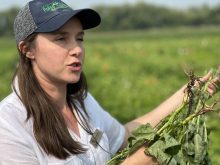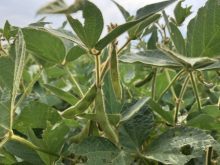The U.S. biodiesel industry has four times the capacity it needs, which poses a serious threat to Canada’s fledgling industry, says an official at the only operating biodiesel plant in Western Canada.
According to statistics from the U.S. National Biodiesel Board, 165 plants operate in the United States with the capacity to produce seven billion litres of fuel. Sales of the alternative fuel are expected to reach 1.7 billion litres in 2007.
That means there are plenty of underused plants that will be looking to sell their highly subsidized product in Canada.
Read Also

Fusarium head blight mycotoxin detector in the works
A PhD student at the University of Saskatchewan has been working on developing a method of detecting fusarium damaged kernels to ease the struggles of producers, agronomists and industry.
“The industry here is still in its infancy,” said Zenneth Faye, executive manager of Milligan Bio-Tech Inc., a small biodiesel production facility in Foam Lake, Sask.
“It would definitely have a negative impact.”
Even scarier are the 80 plants under construction in the U.S. Another 5.3 billion litres of capacity will be added once they come on-line, bringing the total to 12.3 billion litres.
To put that in perspective, the federal government’s biodiesel mandate is expected to create a market for 600 million litres of the fuel in Canada by as early as 2010.
Faye has no doubt U.S. biodiesel manufacturers will aggressively pursue the Canadian market once it is created. In fact, U.S. product is already trickling north.
“They’ve got to survive,” he said.
Gordon Quaiattini, president of the Canadian Renewable Fuels Association, isn’t as nervous about U.S. overcapacity.
“The position of the industry has always been an open border policy,” he said.
“We are going to be prepared to compete with our neighbours to the south, so we don’t see that capacity as a threat.”
As long as Canadian governments match U.S. biodiesel incentives, Canadian plants should be able to use their inherent transportation advantage to fend off American product.
Quaiattini said the federal government has done its part by announcing a two percent mandate and creating a 20 cents per litre producer payment program that starts April 1. Now it is up to provinces to create their own mandates and kick in the additional 10 cents per litre Canadian facilities need to be competitive, he added.
As a last resort the Canadian Renewable Fuels Association could launch an anti-dumping case against the U.S. if American product is exported at rates that are not commercially competitive.
“We will take full advantage of that if required. But again, at this point we’re not anticipating a major concern coming from there.”
Neither is Amber Thurlo Pearson, spokesperson for the U.S. National Biodiesel Board. She said the U.S. supply-demand imbalance is temporary, largely because of soybean oil prices that are near 33-year highs.
“Some may have to be taking a little hiatus from production because of the price of soybean oil,” she said.
However, she figures that is a temporary situation that has a lot to do with futures trading. When the price falls, biodiesel production should rise.
The National Biodiesel Board is also counting on proposed new legislation creating more demand for the product. A bill in front of the U.S. House of Representatives and the Senate is calling for the creation of a renewable fuel standard for biodiesel that would generate a minimum market of 1.7 billion litres in 2008, rising to 4.7 billion litres by 2012.
“Because of favourable proposed legislation to grow biodiesel on the state and federal level, as well as more diesel vehicles being introduced to the U.S. market and a number of other factors, the overcapacity issue could resolve itself over time,” Thurlo Pearson said.
However, a mandated market of 4.7 billion litres still represents only 38 percent of future capacity, so there will still be plenty of biodiesel on the market.
Faye is not only worried about the quantity of biodiesel coming from the U.S. but also the quality. Soy-based product does not perform as well as canola-based biodiesel under harsh winter conditions.
Recently, a client who was looking at buying biodiesel from Milligan ended up going with cheaper U.S. biodiesel.
“When it got to be Dec. 13 and we had an early cold snap, their vehicles were standing on the side of the road. He phoned and said, ‘we’ll never use biodiesel again.’ “
Customers don’t understand there are big differences in the types of biodiesel, not to mention significant quality differences within each type. Faye said the negative publicity associated with the poor cold flow properties of soy biodiesel could damage the overall reputation of the biodiesel industry.















